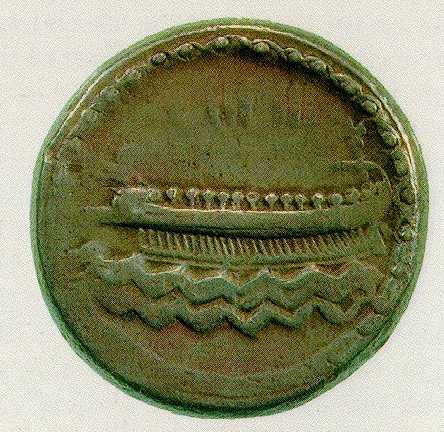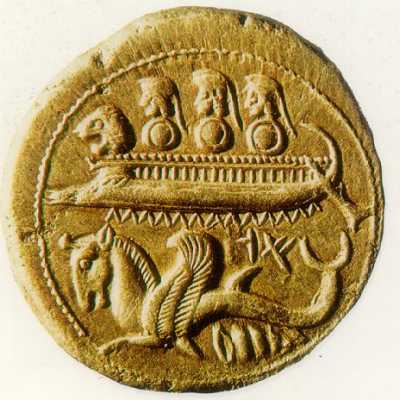
The World Lighthouse Hub
Phoenician Traders
A detailed study of Phoenicians and their culture is given in the downloadable paper: J04 The Phoenicians.


Fig. A15: Two ancient Phoenician coins
The Phoenicians were lucky. Having developed an excellence in travel by sea, they were able to act as traders and merchants for all the materials and artefacts necessary for the development of the other Mediterranean cultures, who did not have ready access to distant lands. At first, prior to 1,200 BC, this was a simple bartering process, where items were exchanged on the basis of their usefulness, but soon the idea of value took hold, and this was based upon the intrinsic perceived value of a metallic material. From 1,000 BC onwards, value was determined by the weight of silver and a scale of value was created. Furthermore, a piece of silver was hallmarked as an indication of its quality. The normal unit of weight was the mina (0.5 kg) that was equal to 50 shekels. A shekel of silver was equal to 200 shekels of copper or 227 shekels of tin. A talent of silver was about 30 kg and was equivalent to 50 minas and 3000 shekels. 1 shekel of gold was equivalent to 4 shekels of silver, but silver was the main trading currency for the next 1,000 years. A kind of currency had been created, although not based upon coins as such.
Interestingly, a period of inflation in this fledgling economy occurred around 750 BC because the amount of silver in circulation was increasing, but the amount of gold, which was much more scarce, was not. This corresponded with the exploitation of a rich new seam of silver ore in what was known as the Rio Tinto mines in the region of Huelva in southwestern Spain. Following a large forest fire in which the ground containing the rich silver ores became very hot, the ground appeared suddenly loaded with a great deal of metallic silver that had been produced by the fire. The native peoples were surprised. They had no use for the silver, but when the Phoenicians saw it they immediately recognised the potential. They traded the silver for quantities of ordinary things that they could supply easily, and then began shipping the silver east to Assyria and Asia. At the time, this was the richest deposit of silver that had been found. The Phoenician ships were loaded with silver until they could carry no more, but it is said they got around this and carried yet more by casting even the anchors in silver. The result in the wider Mediterranean was a devaluation of the currency, but this mattered little to the Phoenicians who had access to as much wealth as they needed. Huelva, meanwhile, developed into a wealthy port based on the smelting of the silver and other metallic ores found close by. It should be realised that the local peoples dealt with all the mining, extraction and land transport issues, whilst the Phoenicians engaged only in its trade and sea transport.
Although coins were not used at first, it is easy to see how the idea of the value of a mass of metal could be developed into a coinage-based currency. The concept of a market economy with its laws of supply and demand and ideas about standardisation of value had been established. The Phoenicians were able to search out new sources of the raw materials for these metals and hence to source the very materials that the Mediterranean civilisations needed for their development. This was to prove the major reason for the expansion westwards, to the farthest reaches of the Mediterranean and beyond, where new sources of copper, silver tin and gold were to be found.